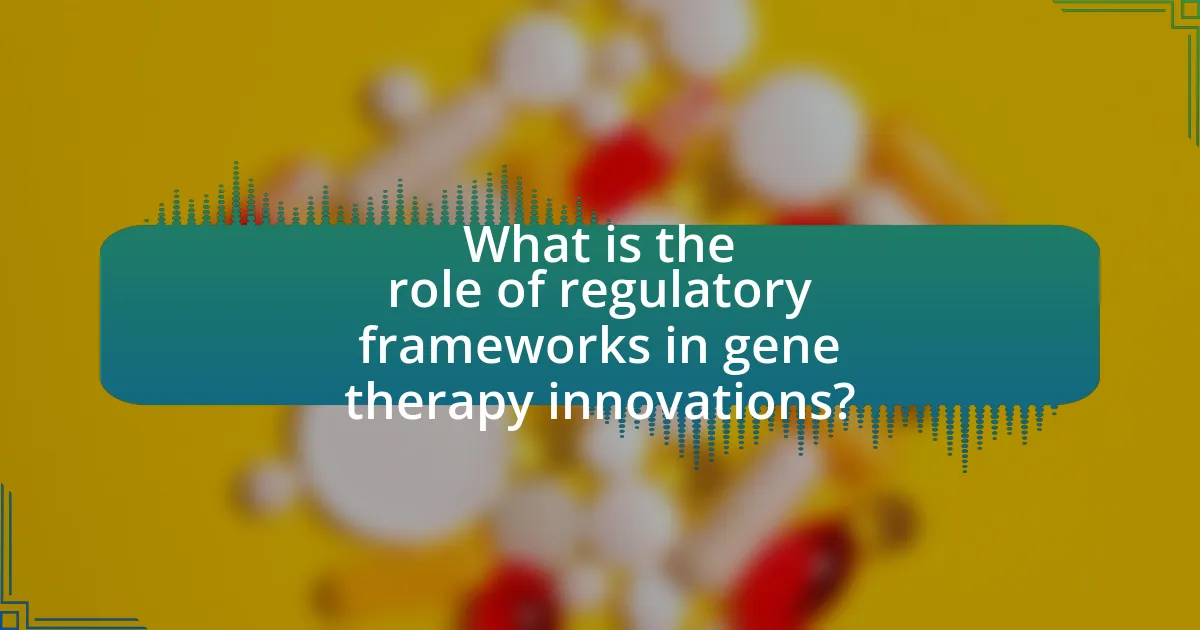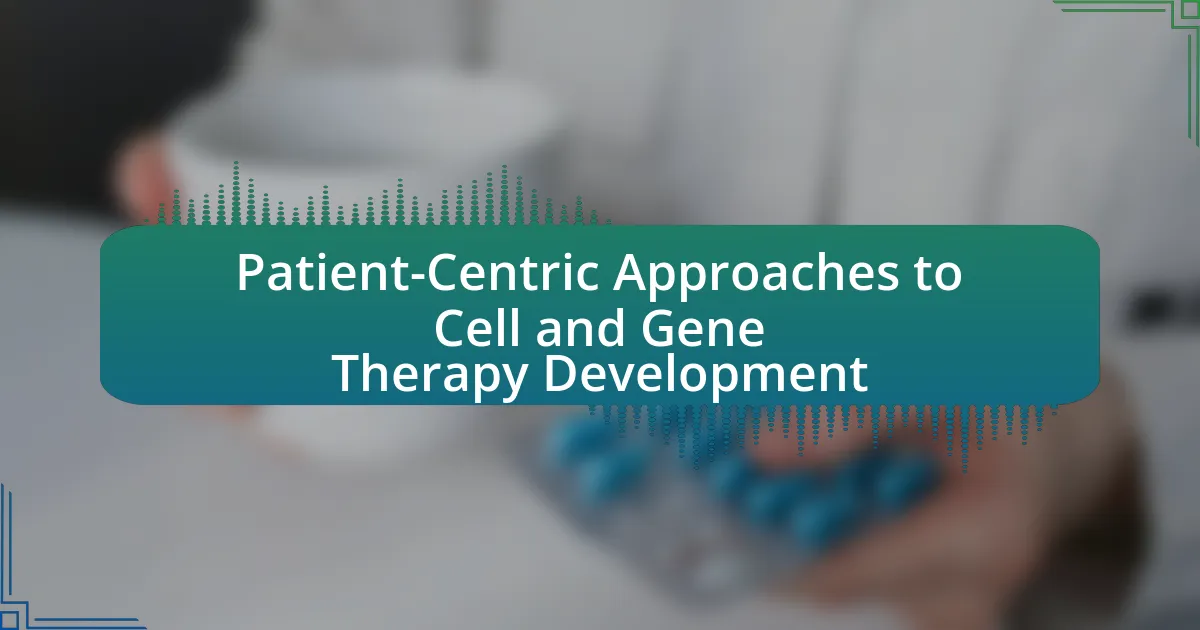The article focuses on the critical role of regulatory frameworks in advancing gene therapy innovations. It outlines how agencies like the FDA and EMA establish guidelines that ensure the safety, efficacy, and ethical standards of gene therapies, influencing their development and market introduction. Key components such as safety assessments, clinical trial oversight, and post-marketing surveillance are discussed, highlighting their importance in protecting public health while fostering innovation. The article also examines the challenges posed by lengthy approval processes and inconsistent regulations across regions, as well as the implications for patient access and affordability of gene therapies. Additionally, it explores future trends and best practices that can enhance regulatory efficiency and promote equitable access to these groundbreaking treatments.

What is the role of regulatory frameworks in gene therapy innovations?
Regulatory frameworks play a crucial role in gene therapy innovations by ensuring safety, efficacy, and ethical standards in the development and application of these therapies. These frameworks, established by agencies such as the FDA and EMA, provide guidelines that govern clinical trials, manufacturing processes, and post-market surveillance. For instance, the FDA’s 2017 guidance on gene therapy outlines the requirements for preclinical and clinical data, which helps streamline the approval process while maintaining patient safety. This regulatory oversight fosters public trust and encourages investment in gene therapy research, ultimately accelerating the introduction of innovative treatments into the market.
How do regulatory frameworks influence the development of gene therapies?
Regulatory frameworks significantly influence the development of gene therapies by establishing safety, efficacy, and quality standards that must be met before therapies can be approved for clinical use. These frameworks, such as the FDA’s 21st Century Cures Act and the European Medicines Agency’s guidelines, provide a structured pathway for developers, ensuring that gene therapies undergo rigorous testing and evaluation. For instance, the FDA’s accelerated approval pathway allows for faster access to promising therapies while still requiring substantial evidence of effectiveness, which can expedite the availability of innovative treatments to patients. Additionally, regulatory frameworks often dictate the types of preclinical and clinical data required, shaping research priorities and resource allocation in the gene therapy field.
What are the key components of regulatory frameworks affecting gene therapy?
The key components of regulatory frameworks affecting gene therapy include safety and efficacy assessments, clinical trial oversight, manufacturing standards, and post-marketing surveillance. Regulatory agencies, such as the U.S. Food and Drug Administration (FDA) and the European Medicines Agency (EMA), require comprehensive preclinical and clinical data to evaluate the safety and effectiveness of gene therapies before approval. These agencies also enforce Good Manufacturing Practices (GMP) to ensure that gene therapy products are consistently produced and controlled according to quality standards. Additionally, post-marketing surveillance is mandated to monitor long-term effects and ensure ongoing safety in the general population. These components are essential for protecting public health while facilitating innovation in gene therapy.
How do these components interact with gene therapy innovations?
Regulatory frameworks interact with gene therapy innovations by establishing guidelines that ensure safety, efficacy, and ethical standards in the development and application of these therapies. These frameworks, such as the FDA’s 21st Century Cures Act, facilitate faster approval processes for gene therapies by allowing adaptive trial designs and expedited pathways, which can significantly reduce the time from research to clinical application. For instance, the FDA has granted Breakthrough Therapy Designation to several gene therapies, enabling developers to work closely with regulators to address challenges and streamline the approval process. This interaction not only promotes innovation but also protects patient safety, ensuring that new therapies meet rigorous scientific and ethical standards before reaching the market.
Why are regulatory frameworks essential for gene therapy advancements?
Regulatory frameworks are essential for gene therapy advancements because they ensure safety, efficacy, and ethical standards in the development and application of these therapies. These frameworks provide a structured process for clinical trials, requiring rigorous testing and evaluation to protect patients from potential risks associated with novel treatments. For instance, the U.S. Food and Drug Administration (FDA) mandates that gene therapies undergo extensive preclinical and clinical testing before approval, which has led to the successful commercialization of therapies like Luxturna for inherited retinal disease. By establishing clear guidelines, regulatory frameworks foster public trust and encourage investment in gene therapy research, ultimately accelerating innovation in the field.
What risks do regulatory frameworks mitigate in gene therapy?
Regulatory frameworks mitigate several risks in gene therapy, including safety concerns, ethical issues, and efficacy uncertainties. These frameworks ensure that gene therapies undergo rigorous preclinical and clinical testing to assess their safety and effectiveness before reaching patients. For instance, the U.S. Food and Drug Administration (FDA) requires comprehensive data on potential adverse effects and long-term outcomes, which helps prevent harmful side effects and ensures that therapies provide the intended benefits. Additionally, regulatory oversight addresses ethical considerations, such as informed consent and equitable access, thereby fostering public trust in gene therapy advancements.
How do regulatory frameworks ensure patient safety in gene therapy?
Regulatory frameworks ensure patient safety in gene therapy by establishing rigorous guidelines for clinical trials, manufacturing processes, and post-market surveillance. These frameworks, such as those set by the U.S. Food and Drug Administration (FDA) and the European Medicines Agency (EMA), require extensive preclinical and clinical data demonstrating the safety and efficacy of gene therapies before they can be approved for human use. For instance, the FDA mandates that gene therapy products undergo a series of phases in clinical trials, which include monitoring for adverse effects and long-term outcomes. Additionally, regulatory bodies enforce Good Manufacturing Practices (GMP) to ensure that gene therapies are produced consistently and safely. This comprehensive oversight is crucial in minimizing risks associated with gene therapy, as evidenced by the stringent approval process that has led to the successful and safe introduction of therapies like Luxturna for inherited retinal disease.
What challenges do regulatory frameworks present to gene therapy innovations?
Regulatory frameworks present significant challenges to gene therapy innovations by imposing stringent approval processes that can delay the introduction of new therapies. These frameworks often require extensive preclinical and clinical testing to ensure safety and efficacy, which can prolong development timelines and increase costs. For instance, the U.S. Food and Drug Administration (FDA) mandates rigorous clinical trials, which can take years to complete, thereby hindering timely access to potentially life-saving treatments. Additionally, the complexity of regulatory requirements can create uncertainty for developers, as evolving guidelines may necessitate additional studies or modifications to existing protocols, further complicating the innovation landscape.
How do lengthy approval processes impact gene therapy development?
Lengthy approval processes significantly delay gene therapy development by extending the time required for clinical trials and regulatory review. These delays can lead to increased costs, as companies must allocate more resources to maintain ongoing trials and comply with regulatory requirements. For instance, the average time for drug approval in the U.S. can exceed 10 years, which hinders timely access to potentially life-saving therapies. Additionally, prolonged approval timelines can discourage investment in gene therapy research, as investors may perceive higher risks associated with uncertain timelines. This ultimately slows the pace of innovation and reduces the availability of new treatments for patients in need.
What are the implications of inconsistent regulations across regions?
Inconsistent regulations across regions can lead to significant delays in the development and approval of gene therapies. These disparities create a fragmented market where companies may face varying compliance requirements, resulting in increased costs and extended timelines for bringing innovations to patients. For instance, a study by the National Academies of Sciences, Engineering, and Medicine highlights that regulatory inconsistencies can hinder collaboration among researchers and manufacturers, ultimately slowing the pace of scientific advancement. Additionally, patients may experience unequal access to potentially life-saving therapies depending on their geographic location, exacerbating health disparities.

How do different countries approach regulatory frameworks for gene therapy?
Different countries adopt varied regulatory frameworks for gene therapy, reflecting their unique healthcare priorities and legal environments. For instance, the United States employs a risk-based approach through the Food and Drug Administration (FDA), which emphasizes preclinical and clinical trial data to ensure safety and efficacy before approval. In contrast, the European Union utilizes a centralized regulatory system via the European Medicines Agency (EMA), which requires comprehensive data on quality, safety, and efficacy, along with post-marketing surveillance. Additionally, countries like Japan have expedited pathways for regenerative medicine, allowing for conditional approvals based on early clinical data. These differences illustrate how regulatory frameworks can influence the pace and nature of gene therapy innovations, with the FDA approving the first gene therapy product in 2017, while the EMA has been more cautious, reflecting its thorough evaluation process.
What are the variations in regulatory frameworks between the US and Europe?
The regulatory frameworks for gene therapy in the US and Europe differ significantly in their approach and requirements. In the US, the Food and Drug Administration (FDA) oversees gene therapy regulations, emphasizing a more streamlined approval process that allows for accelerated pathways, such as the Breakthrough Therapy designation, which can expedite development and review timelines. Conversely, Europe operates under the European Medicines Agency (EMA), which requires a more comprehensive assessment process, including a centralized marketing authorization that can take longer due to additional safety and efficacy evaluations.
These differences are evident in the approval timelines; for instance, the FDA has approved several gene therapies in under a year, while the EMA’s process typically spans several years. Furthermore, the US framework allows for greater flexibility in clinical trial designs, whereas the European framework mandates stricter adherence to predefined protocols. This divergence in regulatory approaches can impact the speed and efficiency of bringing gene therapies to market in each region.
How do these differences affect the speed of gene therapy innovations?
Differences in regulatory frameworks significantly affect the speed of gene therapy innovations by either facilitating or hindering the approval processes. For instance, countries with streamlined regulatory pathways, such as the United States with its Fast Track and Breakthrough Therapy designations, can expedite the development and review of gene therapies, leading to quicker market access. In contrast, regions with more stringent and lengthy approval processes may delay the introduction of new therapies, as seen in some European countries where comprehensive evaluations can prolong timelines. This disparity in regulatory approaches directly influences the pace at which innovative gene therapies are developed and made available to patients, as evidenced by the faster approval rates of gene therapies in the U.S. compared to other regions.
What lessons can be learned from international regulatory practices?
International regulatory practices highlight the importance of harmonization, transparency, and adaptability in fostering innovation in gene therapy. Harmonization across jurisdictions, as seen in the European Medicines Agency’s collaboration with the FDA, facilitates smoother approval processes and encourages global research partnerships. Transparency in regulatory requirements, exemplified by the FDA’s guidance documents, helps stakeholders understand expectations, reducing uncertainty and expediting development timelines. Adaptability is crucial, as demonstrated by the rapid regulatory responses to emerging technologies like CRISPR, which allow for timely updates to frameworks that accommodate scientific advancements. These lessons underscore the need for regulatory bodies to evolve alongside scientific progress to effectively support the growth of gene therapy innovations.
How do emerging markets regulate gene therapy innovations?
Emerging markets regulate gene therapy innovations through a combination of national regulatory frameworks, international guidelines, and adaptive policies aimed at fostering innovation while ensuring safety and efficacy. Countries like Brazil, India, and China have established regulatory bodies that oversee clinical trials, product approvals, and post-market surveillance, often aligning their regulations with guidelines from organizations such as the World Health Organization and the International Conference on Harmonisation. For instance, India’s Central Drugs Standard Control Organization has implemented specific guidelines for gene therapy products, emphasizing the need for comprehensive safety data and ethical considerations in clinical trials. This regulatory approach not only facilitates the introduction of innovative therapies but also addresses public health concerns, ensuring that emerging markets can effectively harness the potential of gene therapy while maintaining rigorous safety standards.
What unique challenges do emerging markets face in gene therapy regulation?
Emerging markets face unique challenges in gene therapy regulation primarily due to limited regulatory infrastructure and resources. These markets often lack established frameworks for evaluating and approving gene therapies, which can lead to inconsistent regulatory practices and delays in access to innovative treatments. For instance, according to a report by the World Health Organization, many emerging economies struggle with inadequate funding and expertise to conduct the necessary clinical trials that meet international standards. Additionally, the rapid pace of gene therapy advancements outstrips the ability of regulatory bodies in these regions to adapt, resulting in potential safety and efficacy concerns for patients.
How can emerging markets benefit from established regulatory frameworks?
Emerging markets can benefit from established regulatory frameworks by gaining access to proven guidelines that enhance the safety and efficacy of gene therapy innovations. These frameworks provide a structured approach to clinical trials, ensuring that new therapies meet international safety standards, which can increase investor confidence and attract funding. For instance, the adoption of frameworks similar to the FDA’s in the United States has been shown to streamline the approval process for new therapies, as evidenced by the rapid approval of gene therapies like Zolgensma, which received FDA approval in just 10 months. By aligning with established regulations, emerging markets can also facilitate collaborations with global pharmaceutical companies, leading to knowledge transfer and capacity building in local healthcare systems.

What future trends can we expect in regulatory frameworks for gene therapy?
Future trends in regulatory frameworks for gene therapy will likely focus on increased flexibility, expedited approval processes, and enhanced patient safety measures. Regulatory bodies, such as the FDA and EMA, are expected to adopt adaptive licensing models that allow for real-time data collection and assessment during clinical trials, facilitating faster access to therapies. Additionally, there will be a growing emphasis on post-market surveillance to monitor long-term effects and efficacy, as evidenced by the recent push for more robust pharmacovigilance systems in gene therapies. These trends aim to balance innovation with safety, ensuring that new treatments can reach patients more efficiently while maintaining rigorous oversight.
How might advancements in technology influence regulatory frameworks?
Advancements in technology can significantly influence regulatory frameworks by necessitating updates to existing laws and guidelines to address new scientific capabilities and ethical considerations. For instance, the emergence of CRISPR gene-editing technology has prompted regulatory bodies like the FDA to reevaluate their approaches to gene therapy, ensuring that safety and efficacy standards are met while fostering innovation. This is evidenced by the FDA’s issuance of guidance documents that specifically address the unique challenges posed by gene editing, reflecting a responsive regulatory environment that adapts to technological progress.
What role does artificial intelligence play in regulatory processes?
Artificial intelligence plays a crucial role in regulatory processes by enhancing data analysis, improving decision-making, and streamlining compliance. AI algorithms can analyze vast amounts of data from clinical trials and real-world evidence, enabling regulators to assess safety and efficacy more efficiently. For instance, the FDA has utilized AI to expedite the review of drug applications, significantly reducing the time required for approvals. This integration of AI not only accelerates the regulatory process but also helps in identifying potential risks and ensuring that innovations in gene therapy meet safety standards.
How can data sharing improve regulatory efficiency for gene therapies?
Data sharing can significantly improve regulatory efficiency for gene therapies by facilitating faster access to comprehensive safety and efficacy data. When researchers and companies share clinical trial results and real-world evidence, regulatory agencies can make more informed decisions, reducing the time required for approvals. For instance, the FDA’s Real-Time Oncology Review program leverages shared data to expedite the review process, allowing for quicker patient access to innovative therapies. This collaborative approach not only enhances transparency but also minimizes duplication of efforts in data collection, ultimately streamlining the regulatory pathway for gene therapies.
What best practices can enhance regulatory frameworks for gene therapy?
Best practices that can enhance regulatory frameworks for gene therapy include establishing clear guidelines for preclinical and clinical trial designs, ensuring robust post-market surveillance, and fostering collaboration between regulatory agencies and stakeholders. Clear guidelines help streamline the approval process, as evidenced by the FDA’s guidance on gene therapy trials, which has facilitated the development of over 20 gene therapies approved since 2017. Robust post-market surveillance ensures ongoing safety and efficacy monitoring, as demonstrated by the long-term follow-up studies required for therapies like Zolgensma. Collaboration among stakeholders, including researchers, industry, and patient advocacy groups, can lead to more informed regulatory decisions, as seen in initiatives like the FDA’s Patient Engagement Advisory Committee, which incorporates patient perspectives into the regulatory process.
How can collaboration between stakeholders improve regulatory outcomes?
Collaboration between stakeholders can significantly improve regulatory outcomes by fostering a shared understanding of the complexities involved in gene therapy innovations. When regulatory bodies, industry representatives, patient advocacy groups, and researchers work together, they can identify potential challenges early, streamline the approval process, and ensure that regulations are both effective and adaptable to new scientific developments. For instance, the FDA’s collaboration with the Coalition for Epidemic Preparedness Innovations (CEPI) during the COVID-19 pandemic exemplified how stakeholder engagement can expedite regulatory pathways, resulting in the rapid development and approval of vaccines. This collaborative approach not only enhances the efficiency of regulatory processes but also aligns them more closely with public health needs and scientific advancements.
What strategies can streamline the approval process for gene therapies?
To streamline the approval process for gene therapies, implementing adaptive trial designs can significantly enhance efficiency. Adaptive trial designs allow for modifications to the trial procedures based on interim results, which can lead to faster decision-making and resource allocation. For instance, the FDA has endorsed this approach, as seen in the approval of therapies like Zolgensma, which utilized adaptive methodologies to demonstrate efficacy and safety more rapidly. Additionally, establishing clear regulatory pathways and guidance documents, such as the FDA’s “Guidance for Industry: Gene Therapy Clinical Trials,” provides sponsors with a structured framework to navigate the approval process effectively. These strategies collectively reduce the time and complexity involved in bringing gene therapies to market.
What are the implications of regulatory frameworks on patient access to gene therapies?
Regulatory frameworks significantly influence patient access to gene therapies by establishing the guidelines for approval, safety, and efficacy. These frameworks, such as the FDA’s accelerated approval pathway, can expedite the availability of innovative treatments to patients with unmet medical needs. For instance, the FDA approved the first gene therapy, Luxturna, in 2017, demonstrating how regulatory processes can facilitate quicker access to life-saving therapies. Additionally, stringent regulations can also create barriers, as lengthy review processes and high compliance costs may delay the introduction of new therapies into the market, ultimately affecting patient access. Thus, while regulatory frameworks aim to ensure safety and efficacy, they also play a critical role in determining how quickly and widely patients can access gene therapies.
How do regulatory decisions impact the affordability of gene therapies?
Regulatory decisions significantly impact the affordability of gene therapies by influencing pricing structures and market access. For instance, expedited approval processes can lead to quicker market entry, which may foster competition and drive down prices. Conversely, stringent regulations can increase development costs, ultimately resulting in higher prices for consumers. A study published in the journal “Health Affairs” found that regulatory frameworks that support innovation while ensuring safety can lead to more cost-effective therapies, as seen with the approval of CAR-T cell therapies, which, despite high initial costs, have shown long-term cost savings in treating certain cancers.
What can be done to ensure equitable access to gene therapy innovations?
To ensure equitable access to gene therapy innovations, regulatory frameworks must prioritize affordability and accessibility in their guidelines. Implementing price controls and reimbursement policies can help make these therapies financially viable for a broader population. For instance, countries like Germany have established health technology assessment processes that evaluate the cost-effectiveness of new therapies, ensuring that they are accessible to patients regardless of socioeconomic status. Additionally, fostering public-private partnerships can facilitate the development of gene therapies that address unmet medical needs in underserved populations, as seen in initiatives like the NIH’s Accelerating Medicines Partnership. These strategies collectively promote equitable access to life-saving gene therapies.




